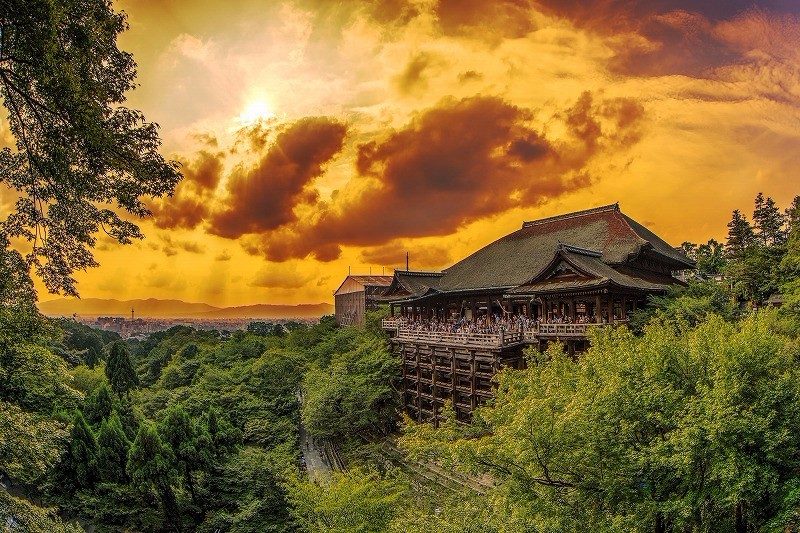
What is Kiyomizu Temple
Kiyomizu Temple is located in Kiyomizu, Higashiyama-ku, Kyoto and is famous for its main hall stage, which is the origin of the phrase “jumping off the stage at Kiyomizu”, and Otowa Falls. It is a popular sightseeing spot in Kyoto City and is visited by many people in all seasons. The main hall, called “Kiyomizu no Butai” (stage of Kiyomizu), is designated as a National Treasure and is made of “Kakezukuri” (suspended structure) without using a single nail.

Simizu Temple
The main hall stage of Kiyomizu Temple is so famous for its stage that it looks as if it has been plunged off a cliff. Along with Kinkakuji Temple and Arashiyama, it is one of the most famous sightseeing spots in Kyoto, representing Japan, even from overseas.
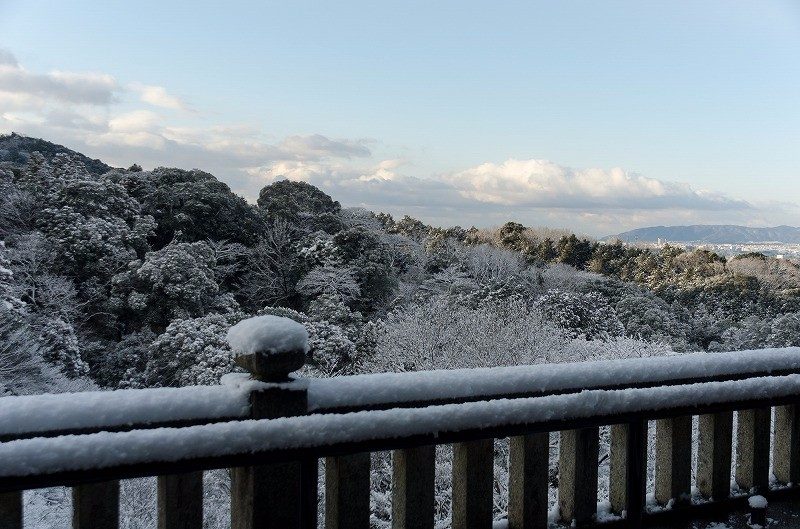
People who jumped off to make their wishes come true
The precincts of Kiyomizu-dera Temple are characterized by the stone walls that have been built and cleared into the middle of Mount Otowa, so that each building is lined up in a row with a row of eaves. Otowa is not so high, at 242 meters above sea level, but the “Kiyomizu-no-butai” (stage of Kiyomizu) makes you realize that it is located in a terrible place.
The main hall is designated as a national treasure and was rebuilt in 1633 with a donation from Tokugawa Iemitsu. 139 zelkova pillars support the “stage” that juts out on the slope without using a single nail.
The phrase “jumping off the stage at Kiyomizu” is used when making a drastic decision, and it is a famous story that some people actually jumped off the stage at Kiyomizu. It is said that there have been 234 recorded cases of people jumping off the stage, many of them believing that if they risked their lives, their wishes would come true and they would be able to attain Buddhahood even if they died. The only thing that is really important is that it is a good place to be.
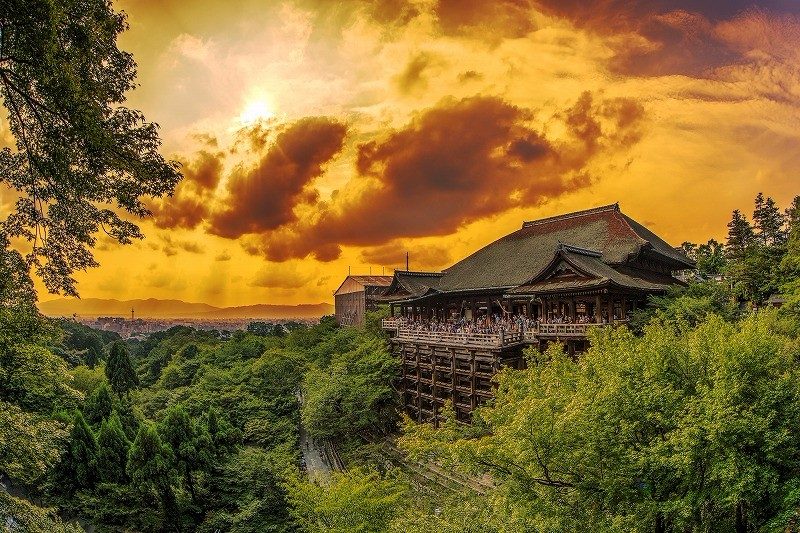
History of Kiyomizu Temple
It was 778, in the late Nara Period. Enchin Shonin was guided by a dream and met Gyoei, a priest who was practicing asceticism at Otowa Falls. Following his words, he carved the Thousand-Armed Avalokitesvara Bodhisattva and built a hermitage around the waterfall. Enchin built the temple with Tamuramaro Sakagami, a warrior who later became a barbarian general, and enshrined the eleven-faced thousand-armed Avalokitesvara Bodhisattva at the temple. This temple is said to be the origin of Kiyomizu Temple. The original founder of the temple was Gyoei, the founder of the temple was Enchin, and the main deity was Tamuramaro Sakagami.
Originally, the temple was dedicated to the Hosso sect of Buddhism.
Originally a temple of the Hosso sect, it later became independent and became the 16th temple of the sacred site of the 33 Kannon temples in the western part of Japan as the head temple of the Northern Hosso sect.
Kiyomizu Temple was officially recognized as a temple in 810. The temple received the imperial sanction of Emperor Saga and was given the name “Kitakannon-ji Temple”.
The history of Kiyomizu Temple has also been a battle against fire. It has burned down nine times, and was rebuilt each time. Today, most of the buildings remaining at Kiyomizu-Dera Temple were rebuilt under the orders of Tokugawa Ieyasu, and many of them have been preserved as national treasures and important cultural properties.

The temple was already famous in the 9th century!
It is said that Kiyomizu Temple was founded in 778, and that the present Kiyomizu Temple was rebuilt during the reign of Tokugawa Iemitsu. It is said that a monk who was training in Yamato Province visited this place following a prophecy in a dream. This is said to have been the origin of Kiyomizu Temple, which was already well known throughout Japan by the 9th century.

Take advantage of a special visit
Kiyomizudera Temple is unique in that the way of viewing the temple changes in accordance with events. The most famous of these is the special nighttime viewing that is held three times a year. During these three seasons, except for winter, visitors can enter the beautiful Kiyomizu Temple at night. Also, every year in August, there is a day of merit called “Sennichimairi”, which is said to bring blessings for 1,000 days in one day of worship, and it is crowded with people who cannot visit the temple often.
Sights of Kiyomizu Temple

Special evening viewing
There are three special nighttime viewing events held in spring, summer and autumn, where about 500 lights are illuminated to create a fantastic atmosphere. The view from Okuno-in Temple, where you can see the main hall surrounded by cherry blossoms, and the view of the cherry blossoms from the stage of Kiyomizu are spectacular, and the illuminated main hall looks as if it is floating.
In the autumn, when the leaves turn red, the trees surrounding the main hall are lit up and their presence is enhanced, creating a spectacular sight.

The compassion of Kannon, a ray of blue light
The single ray of blue light emitted from Kiyomizu Temple into the night sky represents the compassion of the Goddess of Mercy, and can be seen from the city of Kyoto. When the temple is lit up, the temple complex appears more three-dimensional and the atmosphere is more solemn than in the daytime. The night view of the city can also be seen from the inside of the temple.
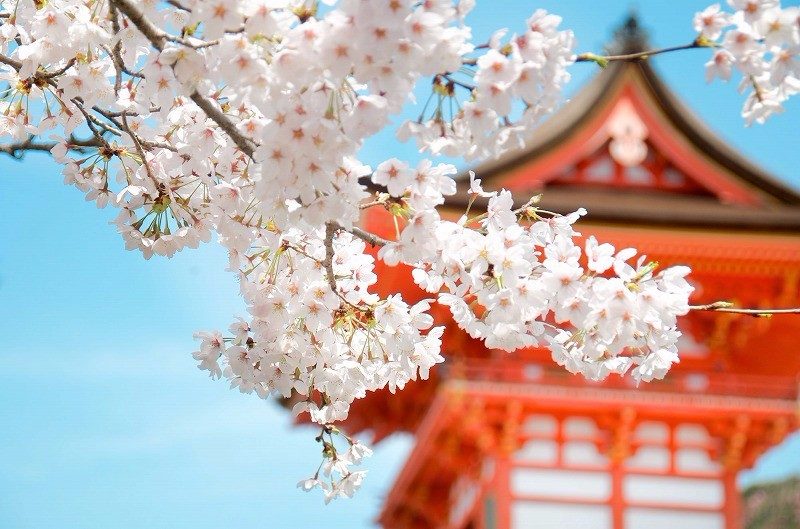
The root of the Five Kannon Principles: Compassion
Avalokitesvara is said to be “the Buddha who sees the sounds of the world freely with his mind”, and the five views, which are the mind of Avalokitesvara, can be said to be the basis of compassion.
The five views of Avalokitesvara’s mind are the basis of compassion: compassion to give joy and happiness to others, grief to eliminate sorrow and suffering, equality towards others and towards life, kindness and compassion, and a heart free of self-interest.
Sunset at Kiyomizu Temple
On a fine day, especially in summer when the days are long, you can see the beautiful main hall of Kiyomizu-dera Temple dyed by the setting sun. Because Kiyomizu-dera Temple is located on the eastern hill, it receives the western sun in the evening, and the main hall illuminated by the setting sun and the lights of the city of Kyoto shining in the distance create a fantastic world different from that of the daytime. The sun gradually setting over Mt. Atago in the distance, just as the sun is shining on the stage of Kiyomizu, is so moving that it is as if you are looking through a kaleidoscope. The colors of the buildings stand out more clearly and vividly in the western sunlight.

Nissokan: The contemplation of the Pure Land
The West Gate of Kiyomizu-dera Temple, one of Kyoto’s most spectacular sunset spots, was once a sanctuary for Nissokan. Nissokan is the practice of watching the sun set in the west and keeping its round shape in mind. It is a part of the practice of seeing the Pure Land of Ultimate Bliss and is described in the Kanmyoujoukyou (Sutra of Immeasurable Life). It is said that the west gate corresponds to the east gate of the paradise. It is said that the Paradise is in the west, the direction where the sun sets, and by praying toward that direction, it is said that you are praying toward the Pure Land.
Jishu Shrine is the god of love fulfillment
Jishu Shrine is located adjacent to the main hall of the temple to the north, and is one of the most famous Jishu shrines in Japan, built in 1633 along with the main hall of Kiyomizu Temple by a donation from Ieyasu Tokugawa. Although the shrine is dedicated to Okuninushi, it has long been treated as part of the temple, and was officially separated from Kiyomizu Temple when the Shinto and Buddhism Separation Order was issued in 1868.
The Jishu Shrine in Kyoto is also known as the god of marriage, and is a popular power spot for young people, with adolescents on school excursions visiting the shrine to find fulfillment in love. If you can safely reach a pair of “stones of love fortune-telling” in the shrine’s precincts with your eyes closed, your love will be fulfilled. It is a common sight to see junior high and high school students with a faint feeling of love fussing over the stones as they try them out. The stone seems to be an ordinary stone, but geologists have discovered that it dates back to the Jomon period, about 16,500 to 3,000 years ago.
Various festivals are held depending on the season, such as the Cherry Blossom Festival in spring, the Tanabata Festival in summer, the Maple Festival in autumn, and the New Year’s Day Festival and Setsubun Festival in winter, attracting many people.

An amazing view! The world famous Kiyomizu no Butai
Kiyomizu Temple is registered as a World Heritage Site as one of the cultural assets of the ancient capital of Kyoto. It is also well known worldwide as a popular tourist spot, attracting foreign tourists from all over the world. During the daytime, the temple is visited by many people from all over Japan and abroad, so it is best to visit early in the morning when there are not many people around.
No nails are used
Kiyomizu Temple was built halfway up the 242 meter high Mount Otowa. The temple is characterized by its stone walls piled up in the middle of the mountain to clear the ground, and the buildings adjoining the temple grounds in the form of eaves. After passing through several halls, we finally reached the main hall. The inner sanctuary faces the cliff, which is the famous “stage of Kiyomizu”. No nails are used, and the view below from the stage is so terrifyingly high that it gives you goosebumps.
The main image is unveiled once every 33 years
The principal image enshrined in the main hall of the temple is opened to the public only once every 33 years.
The main image of the Buddha, which is a secret image that is never shown to the public, is the so-called Kiyomizu-dera style Senju Kannon (Thousand-armed Kannon) with 42 hands.

Scenery you’ll want to see even if you live nearby
The attraction of Kiyomizu Temple is not only for the tourists who visit, but it is said that the scenery is so spectacular that even those who live nearby will want to visit. Because it is located halfway up a mountain, the Kiyomizu stage commands a panoramic view of the city of Kyoto, allowing visitors to enjoy the beauty of the seasons, from cherry blossoms in spring and greenery in summer to autumn leaves in fall and snowy winter scenes in winter.
Lighting up the temple enhances its beauty
If you actually visit Kiyomizu-dera Temple, you will see that there are many tourists from overseas because it is a World Heritage Site. The temple is sometimes lit up at night, and people from all over the world are fascinated by the beauty of the temple as it comes to life at night in Kyoto. Morning and daytime are also recommended, but the sight of Kiyomizu Temple illuminated by light at night is also wonderful.

The terrifyingly beautiful Kiyomizu no Butai
One of the highlights of Kiyomizu-dera Temple is the stage in the main hall. It is 18 meters wide, 10 meters deep, and 13 meters high, with a floor made of Tenryu cypress. Originally, it was a sacred place for performing arts and dances dedicated to the Thousand-armed Goddess of Mercy enshrined in the main sanctuary, and important events are still held here today. Half of the stage is built so that it overhangs the slope of Kinuun Gorge, and the 139 pillars are built without using nails, using a method called “jigokutei,” in which they stand in a combination of lengthwise and crosswise directions. The structure itself is said to be “kake-zukuri” or “butai-zukuri,” but the origin of these techniques is not clearly known, and it is said that they were used to build buildings over water or on cliffs.
The principal image of the Thousand-Armed Avalokitesvara is a secret statue that is opened only once every 33 years, and is usually unseen because of the unusual shape of its 42 hands, two of which are held above the head. The photo of the statue of “You standing”, which is made to imitate the main image, is open to the public, so you can see what the special form of the main image looks like. Similar forms can be found all over Japan and are called “Kiyomizu-dera kata Senju-kannon” or “Kiyomizu-dera kata Senju-kannon”.
The roof is beautifully warped.
The roof is a beautifully warped hinoki-bark hipped roof. On either side of the roof, there is an irimoya style winged corridor that juts out, giving the temple a varied appearance.

Nioimon Gate, the entrance to Kiyomizu-dera Temple
Kiyomizu-zaka, one of the most popular sightseeing spots in Kyoto, is an area packed with souvenir shops. Whoever said that you have to buy souvenirs here when you come to Kyoto!
Kyoto’s most popular sightseeing spot, Kiyomizu-zaka, is packed with souvenir shops.
After passing Kiyomizu-zaka, you will see a bright vermilion gate, which is the Niomon Gate. This gate is the main entrance to the temple and has a hiwadabuki roof with two of the tallest Niomon statues in Kyoto (365cm) on either side. The two guardian dogs are from the Jishu Shrine, and are usually depicted in the “A-form and Un-form” configuration, with one dog with its mouth open and the other with its mouth closed. However, for some reason, the two guardian dogs in front of the Niomon Gate are both in the open-mouthed “A” form, and it is still not known why they were combined in this way, so it is worth taking the time to appreciate them together with the statue of Niou.
Passing through the Niomon Gate, you will see the two statues of Nioh.
After passing through the Niomon Gate, the three-story pagoda rises on the right side. The first pagoda is said to have been built in 847, but it was rebuilt several times after being burnt down several times, and the current pagoda was rebuilt in 1632. The interior is closed to the public and cannot be seen.
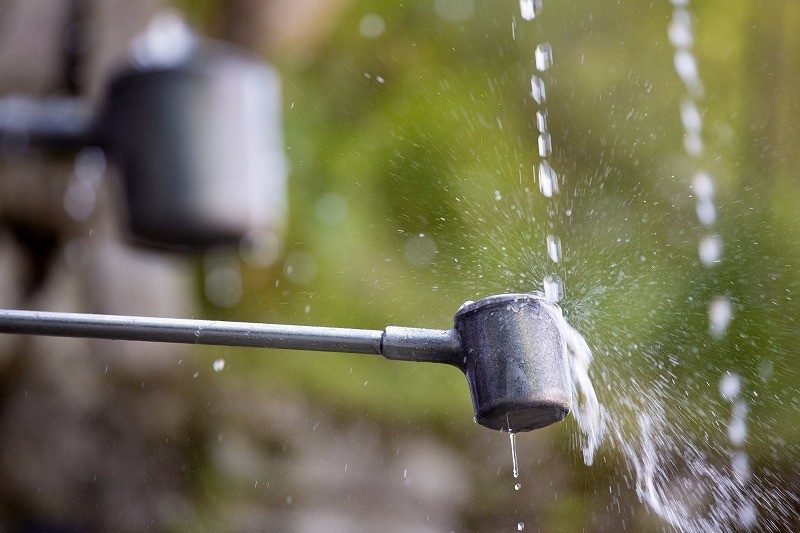
Clear water is the origin of the temple’s name
The Otowa Falls are located down to the right from the stage after the main hall. The waterfall is said to have been flowing uninterrupted for more than 1,000 years. The water flows into the Kyoto basin, and the famous water that never changes has been used and loved for the tea ceremony since ancient times.
It is well known that people line up every day at Otowa Falls to drink the pure water. This is because the three bottles of water are said to be beneficial for “prolonging one’s life,” “fulfilling one’s love” and “improving one’s studies.
It is not necessary to drink all three waters, but it is said that drinking one sip of water is the most beneficial, and if you drink three sips, you will only get a third of the benefits and your wish will be negated. It is also said to be a reminder that greed is not good.
Bottled water is sold for 500 yen a bottle at the “Taki no Do” across from the waterfall basin, and it is said to taste delicious when used to make tea or coffee. Since there are no impurities in the water, the original taste of the water brings out the best flavor. It cannot be purchased in large quantities, but it makes a great souvenir.
Finally, there is a “waterfall shrine” behind the waterfall where Fudo Myoo and the original Gyoei are enshrined. Let’s face the shrine, put our hands together, and take a sip of the pure water.
This is the highlight! Buildings on the temple grounds

Kaizando and Koyando, both associated with historical figures
Designated as an Important Cultural Property, Kaisando was rebuilt at the same time as the main hall, and is an irimoya-style building with a tiled roof. It is also called “Tamura-do” because it houses the statues of the Daihongan, Sakagami Tamuramaro and his wife, and uses a technique called “Tagan-iroku”. This technique, which came from China, is to apply one system color by changing from light to dark colors, and the colors are applied in several stages without using blurring. The difference between this technique and the highly colored decoration used on the three-story pagoda and other structures is also worth enjoying.
The three-story pagoda called “Koyasato” was built as a prayer hall for Emperor Shomu and Empress Komyo, whose prayers were answered and who safely gave birth to Emperor Kouken. It was originally located in front of the Niomon Gate, but was moved to its present location during the Meiji period. Restoration work was completed in 2013, and the brightly painted vermilion pagoda was brought back to life in the modern age.

The beautifully decorated Shakado Hall and Sutra Hall
In the precincts of Kiyomizu-dera Temple, which is lined with many glittering and colorful buildings, Shakado looks simple at first glance, but once inside, the interior is decorated with vermilion-lacquered columns, a long pole in rich colors, and ceiling paintings of celestial maidens, all of which are far more ornate than the exterior would suggest. The temple was destroyed by heavy rain in 1972, but was restored in 1975 using as much of the old wood as possible, restoring it to the appearance it had when it was built in 1631.
The Amida Hall is located to the right of the Shakado Hall. The entire building is painted in rich colors and has a completely different atmosphere from the exterior of the Shakado Hall. As the name suggests, a statue of Amida Nyorai is enshrined here. It is said that Emperor Go-Kashiwabara wrote the plaque, “Japan’s First Buddhist Center for Everlasting Nembutsu”.
The Kyodo Hall, located next to the three-story pagoda, is where learned monks from all over Japan studied. The three statues of Sakyamuni, Monju Bosatsu and Fugen Bosatsu are enshrined here, and a painting of the Nirvana, measuring approximately 4 meters in length and 3 meters in width, is enshrined here and is one of the highlights of the sutra hall.

Lighting and admission fees
The Okuno-in Temple, also known as the “Oku-no-Sende-do”, is a hinoki bark-roofed, hipped building located directly above Otowa-no-taki Waterfall and beyond the Amida Hall. Like the main hall, it was rebuilt in 1633, and although it is now quite faded, it is decorated in rich colors. It is said to be the site of the hermitage of Enchin Shonin and Gyoei Shonin, and is home to the Thousand-Armed Kannon, Bishamonten, and Jizo Bosatsu (Jizo Bodhisattva).
The temple is famous in the Shingon sect of Buddhism.
There are also remnants of the Shingon sect of Buddhism, and Kobo Daishi is enshrined here. The inner sanctuary is built opposite the main hall and can be seen clearly from the main hall’s stage.
Kiyomizu-dera is also famous for its cherry blossoms in the spring and autumn leaves in the fall. The cherry trees, said to number about 1,000, are at their best in early April and are lit up during special nighttime viewing.
The best time to view the autumn leaves is from mid to late November. The fantastic night is illuminated up.
At Kiyomizu-dera Temple, the gates are closed and re-opened for special nighttime viewing after the regular viewing. The temple is open five times a year, and while the regular nighttime viewing costs 300 yen for adults and 200 yen for elementary and junior high school students, visitors must pay an additional 400 yen for adults and 200 yen for elementary and junior high school students during the nighttime viewing.
Hours vary from year to year and season to season.
The hours vary according to the year and season, but the gates open at 6:00 p.m. and close at 9:00 p.m. to 9:30 p.m. On December 31st, the gates are open all night and the temple is crowded with people who come to celebrate New Year’s Eve.
This is the point! Kiyomizu-dera Temple Information

Lunch and cafes to enjoy around Kiyomizu-Dera Temple
If you’re going to Kiyomizu-Dera Temple, you’ll want to pay attention to the food. Kyoto is famous for its yudofu, or boiled tofu. Sohonke Yudofu Okutan Shimizu, located on Sanneizaka, has been in business for over 100 years and is popular for its yudofu, which is made with plenty of homemade tofu. The main ingredient is healthy tofu, so even though it looks hearty, you can eat as much as you want. Higashiyama no Sou,” which is filled with okara (bean curd), is a very popular sweet. Once you try it, you will be addicted to it.
Yoshimura Shimizuan, located in a Taisho era townhouse, is very popular for its freshly ground soba noodles. We recommend the Higashiyama-zen, which comes with half a bowl of soba and a bowl of tempura rice, or the Nishin-soba. The cafe is also popular as a cafe with a variety of sweets on the menu.
The café is a good place to take a break. The parfait using high-grade matcha green tea and sweets in Kyoto-like colors not only look good, but taste good too! Try the Yatsuhashi Parfait at the Yatsuhashi Tea House on Kiyomizu-zaka, where sweets using Yatsuhashi are popular. The green tea parfait and seasonal parfait are a satisfying collaboration of Japanese and Western flavors. Cold noodles and black rice balls are also recommended for a light meal.

Kiyomizu Temple Access
There is no dedicated parking area within the Kiyomizu-Dera Temple precincts, so you will need to use the municipal parking lot or coin parking. During periods when crowds are expected, taxis and public transportation are convenient and reliable.
From JR Kyoto Station, take the city bus. Get off at Gojozaka (Gojozaka slope) bound for Kiyomizu-dera Gion Ginkaku-dera and walk for 10 minutes.
If you take the Keihan Electric Railway, it is about a 25 minute walk as there is no bus service.
If you take the bus or train, it is a 10 minute walk from the bus stop.
If you take the bus or train, you will have to walk at least 10 minutes, but if you take a taxi, it will take you right in front of the temple, so if you are not confident with your legs, consider taking a taxi.
The gates open at 6:00 throughout the year, so if you want to avoid the crowds, early morning is recommended. The gate closes from 5:30 to 6:30 p.m., depending on the season and when the night time visit is held. Service dogs are allowed to enter the temple, but other pets are allowed as long as they are held or placed in a basket.
Barrier-free facilities are being developed.
The temple has been made barrier-free, and wheelchairs and baby strollers are allowed. Unfortunately, the temple does not rent out wheelchairs, so it is best to enter the temple as is.

